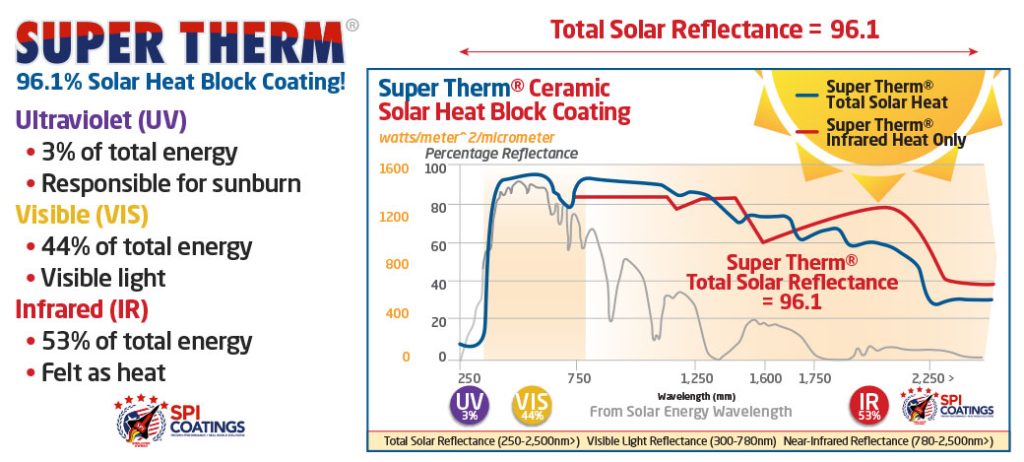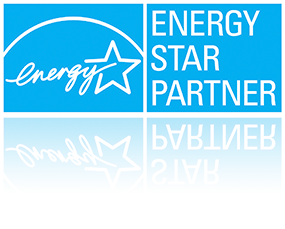Glossary
BTU
A BTU, short for British Thermal Unit, is a standardised measurement of energy. Technically, 1 BTU is roughly equal to the amount of energy required to raise 1 pound of water 1°F. A BTU is the basic measurement used for rating how much energy it takes to produce heat. It’s used in determining the efficiency of air conditioning equipment, furnaces, and any appliances that heat – such as water heaters, ovens, and fireplaces.
In tests, Super Therm® coating reduced the BTU conductivity of material from 350 BTU to 3.77 BTU (99.5% reduction).
TSR
Total Solar Reflectance (TSR) refers to the method of measuring a surface coating’s reflective capability. TSR is usually displayed as a percentage between 0% and 100%. If the percentage is a higher number, that means the surface is more effective at reflecting the radiation from the sun. Surfaces with a higher TSR can stay cooler and last longer than one with a coating that absorbs more of the sun’s radiation. TSR does not measure heat load!

 SRI
SRI
The Solar Reflectance Index (SRI) value combines both the reflectivity value and emittance value as a measure of a coating’s overall ability to reject solar heat, as shown by a small temperature rise. The calculation has a specific calculation that must be followed. It is defined such that a standard black (reflectance 0.05, emittance 0.90) is 0 and a standard white (reflectance 0.80, emittance 0.90) is 100. SRI does not measure BTU’s. See the infographic on SRI >
In tests, Super Therm® coating:
- Reflectivity value 0.83
- Emittance value 0.9
- SRI of 102
Combined with the BTU of 99.5% Super Therm blocks 95% of the heat load/solar heat (blocks the absorption and transfer of heat).
- 99% of Ultra Violet Radiation (UV)
- 92% of Visual Light (Short Wave Radiation)
- 99.5% of Infra Red (Long Wave Radiation)
NOTE: Super Therm® is not a pure white colour, however the extra ceramic compounds proven over 30 years blocks 99.5% of infrared heat unlike other reflective paints making it a true insulation coating and more effective.
Emissivity
Emissivity is defined as the ratio of the energy radiated from a material’s surface to that radiated from a blackbody (a perfect emitter) at the same temperature and wavelength and under the same viewing conditions. All objects at temperatures above absolute zero emit thermal radiation. It is a dimensionless number between 0 (for a perfect reflector) and 1 (for a perfect emitter). Knowledge of surface emissivity is important both for accurate non-contact temperature measurement and for heat transfer calculations.
HVAC
HVAC (heating, ventilation, and air conditioning) is a major subdiscipline of mechanical engineering. The goal of HVAC design is to balance indoor environmental comfort with other factors such as installation cost, ease of maintenance, and energy efficiency.
Thermal Emittance
Thermal Emittance is the measure of a panel’s ability to release heat that it has absorbed. Solar Reflectance Index (SRI) Put Solar Reflectance and Thermal Emittance together and you get the Solar Reflective Index (SRI).
For building products, thermal emittance measurements are taken for wavelengths in the infrared. Determining the thermal emittance and solar reflectance of building materials, especially roofing materials, can be very useful for reducing heating and cooling energy costs in buildings. Combined index Solar Reflectance Index (SRI) is often used to determine the overall ability to reflect solar heat and release thermal heat. A roofing surface with high solar reflectance and high thermal emittance will reflect solar heat and release absorbed heat readily. High thermal emittance material radiates thermal heat back into the atmosphere more readily than one with a low thermal emittance. (Wiki)
Albedo
Solar reflectance (sometimes called albedo – Latin: albedo, meaning “whiteness”) is the ratio of solar energy that falls on a surface to the amount reflected. It is measured with a solar spectrum reflectometer on a scale of 0 (not reflective) to 1: (100 percent reflective).
KW
Kilowatt hour is a unit of energy. If the energy is being transmitted or used at a constant rate (power) over a period of time, the total energy in kilowatt hours is equal to the power in kilowatts multiplied by the time in hours.
U-value
U-value, or thermal transmittance (reciprocal of R-value). Thermal transmittance, also known as U-value, is the rate of transfer of heat through a structure (which can be a single material or a composite), divided by the difference in temperature across that structure. The units of measurement are W/m²K. The better-insulated a structure is, the lower the U-value will be. Workmanship and installation standards can strongly affect the thermal transmittance. If insulation is fitted poorly, with gaps and cold bridges, then the thermal transmittance can be considerably higher than desired. Thermal transmittance takes heat loss due to conduction, convection and radiation into account (source).
K-value
The K value of insulation represents the material’s thermal conductivity or ability to conduct heat. Usually, insulation materials have a K value of less than one. The lower the K value, the better the insulation. The textbook definition of the K value is “The time rate of steady heat flow through a unit area of homogeneous material induced by a unit temperature gradient in a direction perpendicular to that unit area”. Simplified, the K value is the measure of heat that passes through one square foot of material that is one inch thick in an hour. Super Therm® is rated 0.31 (ASTM 1269/1461-92), Fibreglass insulation is rated 0.53 (source).
R-value
An R-value is a measure of how well a convectional insulation resists heat transfer through conduction only. It was developed to test the insulating properties of traditional insulation and ignores heat transfer by radiation and convection. It measures only “conductive heat transfer” – how much and how fast it absorbs heat and transfers it through a specific insulation. R-values are measured in a controlled environment and do not measure insulation against convective or radiational heat transfer. Real world situations can compromise the R-value of traditional insulation substantially. For example, traditional insulation can lose 35% of its R-value when as little as 1.5% humidity is introduced.
VOC
Volatile organic compounds (VOCs) are organic chemicals that have a high vapor pressure at ordinary room temperature. VOCs contribute negatively to air pollution by participating in the chemical reactions that take place in the atmosphere and produce a variety of air pollution effects including the effect known as “smog”. CSIRO Australia states levels for VOCs are (descriptors have been adopted by APAS):
- Very High > 250 g/L
- High 100 – 249 g/L
- Moderate 50 – 99 g/L = Super Therm® is safe at 67 VOC
- Low 5 – 49 g/L
- Very Low < 5 g/L
Convection
Physics tells us that moist air always moves to dry air and heat always moves to cold, this can lead to moisture levels building up in walls and attics and in their insulation. A small 1½% moisture level in a wall will reduce R-level of fiberglass insulation by 36%.
“It’s hard to stay warm in a wet coat”. Testing in Germany showed that Super Therm® coatings removed moisture to regulate those moisture levels in a wall during the first season of use. Their study showed that reducing the moisture (convection level) in a wall makes that wall more energy efficient and just having that dry wall can improve performance of the wall an average of 15%.
Conduction
Conduction occurs when two object at different temperatures are in contact with each other. Heat flows from the warmer to the cooler object until they are both at the same temperature. Conduction is the movement of heat through a substance by the collision of molecules.
Super Therm® is not design as a conductive insulation but a solar heat block.
- Super Therm® is not designed to block conductive heat transfer; Super Therm® blocks radiational heat transfer (solar heat) when applied to the exterior of a building or other enclosure.
- Super Therm® does not have a R-value and is not designed to be used to block conductive heat in the same manner as traditional/fibreglass insulation. Super Therm® is not code-approved anywhere for use as an interior insulation or for use as an insulation having a R-value. It is to be used on external of buildings to reflect solar heat.
- The major benefit of using Super Therm® in building construction is to apply it on the exterior of the building (roof and side walls) to block solar radiation and to prevent solar heat from loading into the building envelope.
- Super Therm® should not be promoted or sold based upon any claim about a R-value or a R-value equivalency.
Solids by Weight
Solids by weight refer to the percent ratio of the mass of the non-fluid particles or dissolved solids in a given mixture relative to the total mass of said mixture or solution. Source
Solids by Volume
Solids by volume refer to the percent ratio of the volume of dissolved solids (non-fluid particles) in a given mixture or solution relative to the overall three-dimensional linear space (i.e., total volume) that is occupied by said fluid mixture or solution. Source
Metric / Imperial Conversions
Degrees Celsius to Fahrenheit
°C = ( °F – 32 ) * ( 5 / 9 )
°F = ( °C * [ 9 / 5 ] ) + 32
Mils to Microns
1 micron = 0.03937 mils
1 mil = 25.4 microns
Square Feet to Square Meters
1 m2 = 10.76 ft2
1 ft2 = 0.3048 m2

























